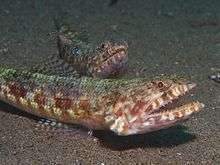Sand lizardfish

.jpg)

| Sand lizardfish | |
|---|---|
| Scientific classification | |
| Kingdom: | Animalia |
| Phylum: | Chordata |
| Class: | Actinopterygii |
| Order: | Aulopiformes |
| Family: | Synodontidae |
| Genus: | Synodus |
| Species: | S. dermatogenys |
| Binomial name | |
| Synodus dermatogenys Fowler, 1912 | |
| Synonyms | |
|
Synodus amaranthus | |
The sand lizardfish (Synodus dermatogenys) is a species of lizardfish that lives mainly in the Indo-Pacific.
Information
The Synodus dermatogenys is known to be found in a marine environment within a reef-associated depth range of about 1–70 meters. This species is native to a tropical climate. The maximum recorded length of the Synodus dermatogenys as an unsexed male is about 24 centimeters or about 9.44 inches. It can be identified by the five or six red-brown vertical bars that intersect a red horizontal broken band on the flank, immediately below this band is a line of whitish dots although the colours can vary depending on the surroundings. This species is native to the areas of Indo-Pacific, Red Sea, Hawaiian, Line, Marquesan, Tuamoto islands, north to Ryukyu Islands, south to Lord Howe, Micronesia, Southeast Atlantic, Algoa Bay, and South Africa. It is common to find this species in sand-rubble areas of lagoon and seaward reefs to over 20 meters of benthic depth. This species buries itself in the sand while exposing its eyes and nostrils. It is known to find this species solitary or in small groups.[1] The Variegated Lizardfish is a predator of small fish and crustaceans, its mouth is full of sharp needle-like teeth.
Common names
The common names of the Synodus dermatogenys include the following:[2]
- Sand Lizardfish
- Clearfin Lizardfish
- Variegated Lizardfish
Classification
The taxonomic classification of the Synodus dermatogenys:
- Kingdom : Animalia
- Phylum : Chordata
- Subphylum : Vertebrata
- Class : Actinopterygii
- Order : Aulopiformes
- Family : Synodontidae
- Genus : Synodus
- Species : Synodus dermatogenys[3]
References
- ↑ "Synodus dermatogenys Fowler, 1912 Sand lizardfish". Fish Base. Retrieved 11 May 2013.
- ↑ "Cook Islands Biodiversity Database". The Cook Islands Natural Heritage Trust. Retrieved 11 May 2013.
- ↑ "ANIMAL SPECIES: Banded Lizardfish, Synodus dermatogenys Fowler, 1912". AustralianMuseum.com. Retrieved 11 May 2013.
Notes
- Froese, Rainer and Pauly, Daniel, eds. (2012). "Synodus dermatogenys" in FishBase. April 2012 version.